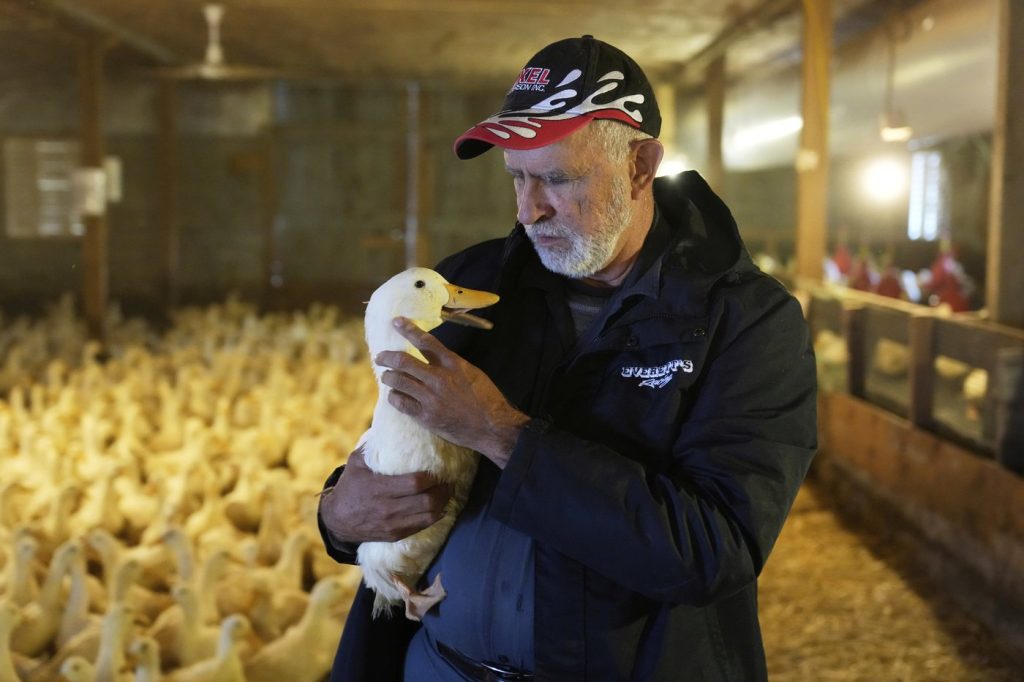AQUEBOGUE, N.Y. — Doug Corwin, a fourth-generation farmer at Crescent Duck Farm, recognized a significant problem at his family’s commercial duck farm in Long Island when he discovered numerous dead and lethargic birds during a barn inspection in January. Shortly thereafter, the farm fell victim to the ongoing global avian flu outbreak, leading to the culling of its entire flock. This grim event has had a profound impact on agricultural markets, resulting in soaring prices for eggs and other commodities.
Founded in 1908, Crescent Duck Farm is the last remaining duck farm in a region of New York that was once known for its duck production. Despite the devastation, Corwin is now cautiously working to rebuild the farm. However, he acknowledges that returning to the previous capacity of 100,000 birds will be challenging. The initial rebuilding efforts rely on ducks hatched from eggs that were spared from slaughter, with Corwin focused on preserving the unique lineage of the birds that have permitted the farm to thrive over the years, despite the decline of other duck farms in Long Island.
Corwin, who is 66 years old, expresses his anxiety about the risk of another flu outbreak, stating, “All I know is I don’t want to be hit again. If I go through this twice, I’m done as a duck farmer.” In an effort to mitigate future risks, Corwin and his limited staff have implemented extensive sanitation measures, including clearing hay and debris and replacing critical infrastructure such as feeders and ventilation systems.
In May, the farm welcomed its first batch of young ducks—about 900 that had been raised under careful quarantine. Following this, another similar batch was introduced, with further arrivals expected. Corwin anticipates that these ducks will be ready for market by the end of next summer; however, he stresses that he will not rush the reopening, acknowledging the long road ahead before the farm returns to its previous operational scale of processing approximately 1 million ducks annually.
The bird flu outbreak, particularly the virulent H5N1 strain, has been detected across all 50 states since 2022, affecting nearly 175 million birds and leading to over 1,700 recorded outbreaks. Dr. Gavin Hitchener, director of Cornell University’s Duck Research Laboratory, has noted that this particular strain has affected a wider array of species than previous variants, indicating a change in the virus’s makeup that has allowed it to become more virulent.
Despite receiving federal compensation for the ducks that were euthanized, Corwin expresses concern that the amount did not come close to the true market value of the birds, especially considering the high costs associated with rebuilding in a region that includes the Hamptons. He advocates for the vaccination of poultry against bird flu, despite the challenges posed by existing political and industrial opposition. “I would sleep an awful lot better at night. But right now I’m very nervous,” he said, expressing the gravity of the situation as he likened it to “playing with deck chairs on the Titanic.”
The newly arrived ducks are vital for the revival of the farm. They are predominantly white Pekin ducks, representing the genetic heritage that Corwin's family has carefully preserved over generations. This lineage is critical, given that Crescent Duck Farm has remained the only commercial duck operation in Long Island for nearly a decade. At its peak in the early 1960s, Long Island boasted over 100 farms producing two-thirds of the nation’s duck output.
Corwin feels a strong obligation to honor his ancestors who have contributed to the farming legacy, saying, “I feel I owe it to the ancestors of farmers who’ve been here all these years and have come this far to just make a go of it. I want to make Long Island proud.”










